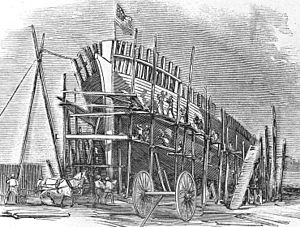USS Seneca (1861) facts for kids

USS Seneca
|
|
Quick facts for kids History |
|
|---|---|
| Name | USS Seneca |
| Builder | J. Simonson |
| Laid down | date unknown |
| Launched | 27 August 1861 at New York City |
| Commissioned | 14 October 1861 at the New York Navy Yard |
| Decommissioned | 24 June 1865 at Norfolk, Virginia |
| Stricken | 1868 (est.) |
| Homeport | Norfolk, Virginia |
| Fate | sold on 10 September 1868 |
| General characteristics | |
| Class and type | Unadilla-class gunboat |
| Displacement | 691 tons |
| Tons burthen | 507 |
| Length | 158 ft (48 m) (waterline) |
| Beam | 28 ft (8.5 m) |
| Draft | 9 ft 6 in (2.90 m) (max.) |
| Depth of hold | 12 ft (3.7 m) |
| Propulsion | 2 × 200 IHP 30-in bore by 18 in stroke horizontal back-acting engines; single screw |
| Sail plan | Two-masted schooner |
| Speed | 10 kn (11.5 mph) |
| Complement | 114 |
| Armament |
|
USS Seneca was a special type of warship called a gunboat. It was built for the United States Navy to serve during the American Civil War. The Seneca had powerful guns that could fire straight ahead. It also had two smaller guns called howitzers for attacking targets on land. With a crew of 84 sailors, the ship helped the Union blockade the ports of the Confederate States of America.
Contents
The Seneca was one of many "Ninety-day gunboats" built quickly for the war. It was the first ship in the United States Navy to be named Seneca. The ship was built in New York City by Jeremiah Simonson. It was launched, or put into the water for the first time, on August 27, 1861.
The Seneca officially joined the Navy on October 14, 1861. This happened at the Brooklyn Navy Yard in New York. Lieutenant Daniel Ammen was put in charge of the ship. His second-in-command was John G. Sproston.
Serving in the Civil War
Blockading the Coast
On November 5, 1861, the Seneca and three other Union gunboats fought a group of Confederate ships. This happened near Port Royal, South Carolina. Two days later, the Seneca helped capture Port Royal. This place became a very important naval base for the Union during the war.
From November 9 to 12, the Seneca helped take over Beaufort, South Carolina. On December 5, the ship joined operations near Tybee Sound. This helped to block off Savannah, Georgia. The next day, the Seneca was nearby when the schooner Cheshire was captured. This meant its crew shared in the prize money.
From January 1862 to January 1863, the Seneca worked along the coast. Its area of operation stretched from Wilmington, North Carolina down to Florida. On January 27, 1863, the ship took part in an attack on Fort McAllister. It also participated in a second attack on February 1.
On February 28, in the Ogeechee River, the Seneca helped another ship, the USS Montauk. They worked together to destroy a privateer ship called Rattlesnake. This ship used to be a Confederate warship known as CSS Nashville. In July 1863, the Seneca was part of the ships that attacked Fort Wagner.
After these missions, the Seneca returned to the New York Navy Yard. It was taken out of service on January 15, 1864.
Later Battles and Honors
The Seneca was put back into service on October 3, 1864. Commander George Belknap was now in charge. The ship was assigned to the North Atlantic Blockading Squadron. This group of ships helped block Confederate ports.
From December 24 to 25, the Seneca took part in an attack on Fort Fisher. This attack was not successful at first. However, from January 13 to 15, 1865, the ship joined a second, successful attack. This battle finally captured Fort Fisher. This was a big win because it closed Wilmington, North Carolina, which was the last major seaport for the Confederacy.
One of the Seneca crewmen, Chief Boatswain's Mate Othniel Tripp, was given the Medal of Honor for his brave actions in that battle. On February 17, the Seneca was part of the force that attacked Fort Anderson. They captured it two days later.
After the War
When the Civil War ended, the Seneca sailed to Norfolk, Virginia. It was officially taken out of service on June 24, 1865. The ship was later sold on September 10, 1868, to a company called Purvis and Company.



